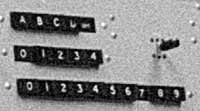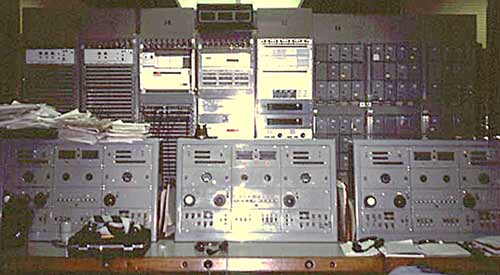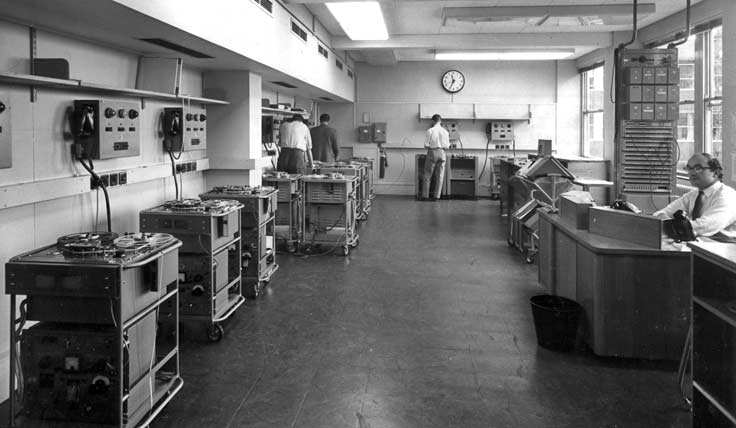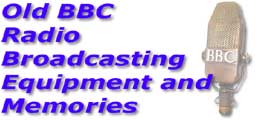
Control Room of Broadcasting House, London
Construction - 1 | Construction
- 2
Uniselectors | Sources | 1960s | 1980s
Memories | Recruitment
Home Page
Uniselectors | Sources | 1960s | 1980s
Memories | Recruitment
Home Page
Sources and source codes in 1961. Notes by Barry Taylor.

* These sources also appeared in the separate Television
Source Mult which used Y or Z codes to avoid confusion with the main mult.
| A00 |
Related pages
|
| A01-A05 | Despatch 1 - CH1-5
- Despatch Cubicle 1. The Despatch Position was designed to centre
all news items in one area under the control of a 'Master Operator'
assisted by a relief operator. Normally 4 simultaneous circuits could
be handled. In practice 4 simultaneous circuits were quite rare. The
Despatch Position only handled overseas circuits, namely those from
Europe via IMC, from North America via TAT and anywhere else on radio
circuits via RT. Having liaised with the GPO operator, the Despatch Position operator briefly confirmed two-way contact with the reporter/correspondent and then switched the Traffic Manager 'into the circuit'. The first priority for the Traffic Manager was to record (on machines remotely started by her in H30, Alexandra Palace and Bush House) the reports the correspondent was filing. After this was done messages were passed (international telephone dialling was yet to come). If necessary and on request to the Traffic Manager, News Editors in Bush House and Alexandra Palace (where TV News was based) could speak to the correspondent. This facility was enabled by the Despatch Position operator who may have been monitoring the circuit or if not the Traffic Manager had a direct phone line to him/her to request the facility. Provision was also made for live inserts into news bulletins (a very rare event in the early 1960s) with conference facilities planned for 3G, 3F (both in Egton House where the newsroom was located) and Mixer 1A. The latter was changed to 3B when that new mixer studio was completed and the newsroom moved from Egton House to the 3rd floor of BHX. The conference network that made the facilities described work was in fact a very large clean feed network such that everyone could hear everyone else but not themselves to avoid howl-rounds if loudspeakers were in use. This was achieved with a matrix of 50dB attenuators. The conference feed to Bush House (for example) then consisted of everyone except Bush House paralleled together and fed through an amplifier with a gain of about 50dB. A total of 21 amplifiers was needed and as space was limited these were transistor amplifiers, the only ones in the whole of the 1960s control room. These were 3 stage amplifiers using germanium transistors and basically designed as mic amps. The first versions of this amp used a GET6 followed by an OC71 and OC72, later versions used a GET106 followed by two GET104s. |
| A07-A09 | 3 CH Mixer 1 - A, B and C - A three-channel
mixer with 3 separate outputs located in the same cubicle as Despatch
Cubicle 1. Treated as a spare to the mixer in Despatch Cubicle 2. |
| A11 - A15 | Despatch 2 - CH1-5 - Despatch Cubicle
2. Identical to Despatch Cubicle 1 and only used if there was a fault
or routine maintenance in Cubicle 1. See above. |
| A17 - A19 |
3 CH Mixer 2 - A, B & C - A three-channel mixer
in Despatch Cubicle 2 identical to that in Cubicle 1. Occasionally
used to mix 2 or 3 London OB contributions to regional Home Service
sports programmes. Later the area became the cubicle of Continuity
G. |
| A21 - A32 | C&M 1-6 - A & B - Control
and Monitor Positions. The direct descendants of the control positions in the 1932 control room and the 'Bays' in the Wartime control room. Normally used as 6 positions each with two independent outputs, each pair could, by operation of a single switch, be converted to a 2-channel mixer with a main gain control and 4 independent outputs. |
| A36 |
London Airport - The unattended BBC studio at the Airport,
usually abbreviated to LAP. (The airport is better known today as
London-Heathrow, LHR). |
| A37 | St. Stephens - The unattended (i.e.
no engineer or studio manager) BBC studio from where Parliamentary
correspondents filed their reports. |
| A38 - A46 | Aeolian Studios 1 & 2; Camden; Farringdon;
Jubilee; Paris Cinema; Piccadilly 1 &2; Playhouse - The
Outside Studios now long since closed. 'The Goon Show' was recorded
in the Camden Theatre and sometimes in The Paris, a converted cinema.
The Paris was also the venue for 'Beyond Our Ken' and 'Round the Horne'.
(The Paris was always so called in the Control Room to avoid any confusion
with the BBC studio in the French capital, which was always referred
to as Paris France). |
| A47 | GA Western - A small studio in
Western House. |
| A48 |
LH 1 - A medium sized drama studio in The Langham. Other
studios in what was once, and is now again, The Langham Hotel were
used for staff training. |
| A49 | The Grafton - Another outside studio. |
| B00 | S1 - BH sub-basement, the studio
known earlier as BB. |
| B01 | B1 - BH basement.  B1 was the major events mixer soon to be superseded by Mixer 1A. |
| B02 | B2 - BH basement. A small studio. |
| B04 |
RM4 - Recording Mixer 4 sharing the same studio as B2.
Originally intended for mixing record programmes without speech; it
was booked as 'B2 +RM4' when the studio was required. After the B2
desk was removed it simply became B4. |
| B05 | B5 - BH basement studio. |
| B06-B16 | Destined to be the codes for the new BH extension
studios B6 - B16 which were still under construction at the time of
this listing. CH, the Concert Hall, on B16 was later
moved to another code. B11 was allocated to 1B which
was a lip mic in the Sports Room in Cavendish Mansions. |
| B17 | L1 - Lower Ground BH immediately
under Reception. The so-called VIP studio, decorated with glassware
displayed in cabinets. |
| B18 | L2 - Lower Ground Cavendish Mansions.
The Radio Newsreel studio. |
| B19 | 1A - Studio on the first floor
of Egton House always called 1A Egton to avoid confusion with Mixer
1A. Later renamed as Egton 1. |
| B20 - B30 |
3A, 3B, 3C, 3D, 3E, 3F, 3G, 4A, 6A, 6C & 8A - BH
studios except news studios 3F and 3G which were in Egton House. (The
newsroom was in Egton House at this time). These two were later renamed
Egton 2 and Egton 3. 8A, a drama studio, was often referred to as
'Studio 8' rather than 8A. |
| B31-35 | MV1 - 5 - Music studios in Maida
Vale. |
| B36 - B40 | PP1 - 5 - Schools and small talks
studios in 1 and 1A Portland Place. |
| B45-47 | H50; H53 & H56 - Recording channels
on the fifth floor of BH extension. These had studios with a Type
B Mk II desk in H50 and H53 and a Marconi in H56. |
| B48-B49 |
 |
| C00-C06 |
BM271, BM549, BS154, BS222, BS275, DX689, LS683 - Incoming
lines known as SB (Simultaneous Broadcast) lines which, more correctly,
should have been called Regional Contribution lines. BM, BS, DX and
LS are GPO abbreviations for Birmingham, Bristol, Daventry and Leeds.
The numbers are abbreviated GPO line designations. For example BS275
was PW12275, the PW standing for Private Wire. (Lines wholly within
the GPO London Region were coded PW/LR.) |
| C07-C10 | Bay 65 Jack Inlets 1 - 6 - Pluggable
inputs to the source mult located on Bay 65 (adjacent to OB and TV
positions). |
| C11-C30 | OB Chains 1 - 20 - Outside Broadcast
Chains of pre-wired and/or normalled equipment i.e. Rep. coil, passive
equaliser, attenuator and D amplifier. |
| C31-C36 |
IMC1 - 6 - IMC stands for International Maintenance
Centre, a section of the GPO that dealt with circuits to Europe. On
these codes were local ends from IMC for music, cue and control lines
following the convention of music line=1, control line=51, cue line=101.
These were not of course the actual GPO line numbers but were a very
convenient shorthand for liaising with and booking lines on and off
with IMC. |
| C37-C40 |
Related page
|
| C41 - C43 | RT1-3 - Lines from the GPO Radio
Terminal at Brent. Outside of Europe and North America all news material
arrived by radio telephone circuits. (Music and Cue lines.) |
| C44 - C45 | TAT1 - 2 - Lines from the GPO Trans-Atlantic
Terminal for circuits to USA and Canada. (Music and Cue lines.) |
| C47 - C48 | Bush 1 - 2 - Two circuits from Bush
House. |
| D00 |
Big Ben - Output from a BBC microphone and amplifier
at Westminster. Announcers have been known to cue 'the chimes of Big
Ben'. Wrong, of course, as Big Ben is the large bell which produces
the strokes and its four companions are responsible for the chimes. |
| D01 - D06 | SB Replacement 1 - 6 - The outputs
of chains of equipment similar to OB chains and intended for the replacement
of SB lines under fault conditions or if the GPO needed to do work
which would make an SB line LTI (liable to interruption). In practice
the replacement circuit was overplugged so that it appeared on the
code of the line it was replacing. |
| D07 | 1000 cps - 1000 cycles per second
tone. The use of Hertz for frequency was yet to come. |
| D08 | 1000 cps 30 secs - A pulse of 1000
cps tone every 30 seconds on the minute and half minute with a long
decay time. Known as 'bing tone'. |
| D09 | 440 cps - 440 cycles per second
tone. |
| D10 | 440 cps 30 secs - 440 cps bing tone
similar to D08. |
| D11 |
440 cps 10 secs - 440 cps 10 second bing tone which
did not occur at exactly 00,10,20,30,40 and 50 seconds past each minute
but varied by ±2 seconds over the minute. The 50 sec. bing
actually occurred at 52 seconds. |
| D12 | Test Oscillator - Output of a test
oscillator for frequency response test on lines. Done manually originally
but replaced circa 1965 by a sweep oscillator and automatic pen chart
recorders in the regional centres. |
| D13 | SB Test Room - Output from Lines
department test room. |
| D14-D15 | Source Switch TV 1 & 2 - Two
sources from the TV sound position (not BBC1 and BBC2 - there was
still only one network at this time). |
| D16-D17 |
Home, Light, Third, Green and TV Sound Distributions
- Home, Light and Third were feeds from the output of the continuity
interchange unit. Green was GOS - the General Overseas Service - more
or less what today is called World Service, and came from Bush House. |
| D23-D25 |
Red, Purple and Chain 22 - Programme feeds from Bush
House. Chain 22 was fed to the Droitwich transmitter following Light
Programme closedown after the midnight shipping forecast. |
| D26 - D27 | TV Main and Reserve - Two feeds
of what was then the one and only BBC Television channel. |
| D28 - D34 |
Related page
|
| D35 - D37 | Sw/C BM/BS/ROW Opt-Out - Opt-out
TV sound feeds from TV Switching Centre (based in BH). (ROW=Rowridge,
the south of England transmitter on the Isle of Wight.) |
| D39 | CBC Langham - Output from a small
office/studio in The Langham used by CBC (Canadian Broadcasting Corporation)
before they moved to their own premises in Gt. Titchfield Street in
the late sixties. |
| D40 |
Emergency AMC - There was an 'Emergency' Mic socket
in Type A studios that went direct to Control Room. In the event of
a failure of a studio's equipment its mic would be plugged to this
microphone amplifier. |
| D41 - D45 | Spare GPA I/P 1 - 5 - Spare amplifier
outputs. |
| D46 - D48 | Tatsfield 1 - 3 - Three lines from
the BBC receiving and monitoring station at Tatsfield. |
| D49 | GTS - Greenwich Time Signal which to make line failure detectable was generated as continuous tone with 6 gaps before every hour and 15, 30, 45 minutes after the hour. It was sourced from the Royal Observatory, Herstmonceux, Sussex. The 'pips' were generated in BH by gating a tone source with the incoming signal. |

